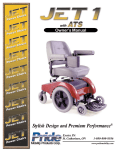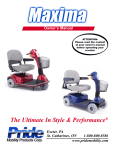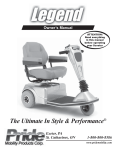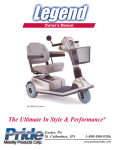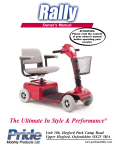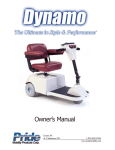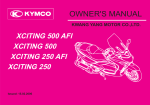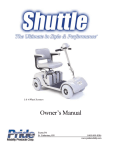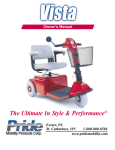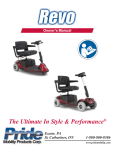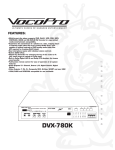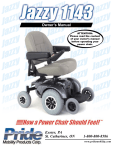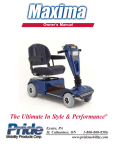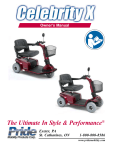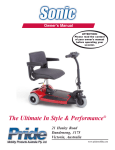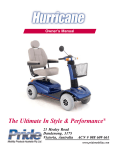Download The Ultimate In Style & Performance®
Transcript
Owner’s Manual ATTENTION: Read everything in this manual before operating your Laser The Ultimate In Style & Performance® Exeter, PA St. Catharines, ON 1-800-800-8586 www.pridemobility.com S A F E T Y G U I D E L I N E S Read and follow all of the instructions in this manual before you attempt to operate your Scooter for the first time. If you are unable to understand any of this information or require additional assistance for setup, contact your authorized Pride provider or call the Pride Technical Service department at 1-800-800-8586 (or call 1-877-800-1248 and dial (7) for the Scooter department). The following symbols will be used throughout this owners manual to identify warnings and cautions. It is very important for you to read and understand them completely. WARNING! Failure to heed the warnings in this owners manual may result in personal injury. CAUTION! Failure to heed the cautions in this owners manual may result in damage to your Scooter. Copyright © 2002 Pride Mobility Products Corp. INFMANU1381/REV D/OCTOBER 2002 2 Laser C O N T E N T S I. INTRODUCTION ......................................................................................................................... 4 II. SAFETY ......................................................................................................................................... 6 III. EMI/RFI .......................................................................................................................................... 9 IV. SPECIFICATIONS ................................................................................................................... 11 V. DESCRIPTION .......................................................................................................................... 13 VI. BATTERIES AND CHARGING ............................................................................................ 19 VII. OPERATION ............................................................................................................................... 23 VIII. COMFORT ADJUSTMENTS................................................................................................ 25 IX. DISASSEMBLY AND ASSEMBLY ..................................................................................... 28 X. OPTIONAL ACCESSORIES ................................................................................................. 31 XI. BASIC TROUBLESHOOTING ............................................................................................. 32 XII. CARE AND MAINTENANCE ................................................................................................ 34 XIII. WARRANTY ............................................................................................................................... 36 Laser 3 I . I N T R O D U C T I O N Welcome to Pride Mobility Products Corporation (Pride). Congratulations on the purchase of your new Pride Scooter. Your Scooter design combines the most advanced state-of-the-art components with modern, attractive styling. We are certain that the design features and trouble-free operation will add convenience to your daily living and ensure complete satisfaction. At Pride, your safety is important to us. Please read and follow all of the instructions in this manual before you attempt to operate your Scooter for the first time. These instructions were produced for your benefit. Your understanding of these instructions is essential for the safe operation of your new Pride Scooter. Pride is not liable for damage to property or personal injury arising out of unsafe use of a Pride Scooter. Pride is also not liable for any property damage or personal injury arising out of the failure of any person and or/user to following the instructions and recommendations set forth in this manual or any other instructions or recommendations contained in other Scooter related literature issued by Pride or contained on the Pride Scooter itself. This owners manual is compiled from the latest specifications and product information available at the time of publication. We reserve the right to make changes as they become necessary. Any changes to our products may cause slight variations between the illustrations and explanations in this manual and the product you had purchased. If you experience any problems with your Scooter that you are unable to solve, or if you do not feel capable of safely following any of the instructions and/or recommendations as contained in this manual, please contact your authorized Pride provider for assistance. Once you understand how to operate and take care of your Scooter, we are certain that it will give you years of troublefree service and enjoyment. Information Exchange We want to hear your questions, comments, and suggestions about this manual. We would also like to hear about the safety and reliability of your new Pride Scooter and the service you received from your authorized Pride provider. Please notify us of any change of address so we can keep you apprised of important information about safety, new products, and new options that can increase your ability to use and enjoy your Pride Scooter. Please feel free to write us at the address below: Pride Mobility Products Corporation Attn: Technical Service Department 182 Susquehanna Avenue Exeter, PA 18643-2694 1-800-800-8586 4 Laser I . I N T R O D U C T I O N Pride Owners Club As an owner of a Pride product, you are invited to register your products warranty and enroll in the Pride Owners Club. You may do so by filling out and returning your enclosed registration card or by visiting Prides web site at www.pridemobility.com. As a registered member, each time you visit our site, you will have access to the most interactive and honest educational venue available today for people with mobility needs, their families, and friends. From our home page, click on the button that reads Owners Club to enter a page dedicated to current and potential Pride product owners. You will gain access to interviews, stories, recreation ideas, daily living tips, product and funding information, and interactive message boards. On these message boards you are invited to speak with other Pride customers as well as Pride representatives who are available to assist you with any questions or concerns you may have. You will receive a free gift simply for registering with the Pride Owners Club. My Authorized Pride Provider Is: Name:_______________________________________________________________________________ Address:_____________________________________________________________________________ Phone Number:________________________________________________________________________ Quick Reference Information: Scooter Model:________________________________________________________________________ Serial Number:__________________________________________________________________________ Purchase Date:________________________________________________________________________ NOTE: If you ever lose or misplace your warranty card or your copy of this manual, call or write to us and we will be glad to send you a new one immediately. Laser 5 I I . S A F E T Y SAFETY PRECAUTIONS n Do not operate your new Laser for the first time without completely reading and understanding this owners manual. n Do not carry passengers on your Laser. n Do not leave the key in the key switch when your Laser is unattended. n Make certain that the seat is locked into place and that the key is removed from the key switch before getting on or off of your Laser. Also make certain that the seat is in a locked position when you operate your Laser. n Reduce your Lasers speed when you are operating it on uneven terrain and/or soft surfaces. n Reduce your Lasers speed when you are driving it around a corner. n Never drive your Laser across the side of a hill or diagonally up or down a hill. Never stop, if possible, while driving up or down an incline. n Proceed with extreme caution as you approach the downgrade of a ramp or other incline. n Proceed with caution when driving near a raised surface, unprotected ledges, or drop offs (curbs, porches, stairs, etc.). n Never remove your Lasers anti-tip wheels or modify the Laser in any way that is not authorized by Pride. n Use extreme caution when operating your Laser on busy streets and in parking lots or shopping malls and never ride your Laser where you cannot safely and legally walk. Consult local municipal or state agencies with regard to operating your Laser on public roadways. n Do not operate your Laser while you are under the influence of alcohol. n Check with your physician if you are taking any medications that may affect your ability to operate your Laser safely. n Keep your hands on the tiller and your feet on the floorboard when you are operating your Laser. n Make certain that the tires are properly inflated (30 psi). n Never use your Laser as a seat in a moving vehicle. n Make certain that the Lasers batteries are properly secured when you transport your Sport Scooter in another vehicle. n Disconnect your Lasers batteries if you will not be using the Sport Scooter for more than 48 hours. WARNING! Battery posts, terminals, and related accessories contain lead and lead compounds. Wash hands after handling. WARNING! Do not expose the electronics to any type of moisture at any time (i.e., rain, snow, mist, or washing the Sport Scooter). Such exposure can damage the electronics. Never attempt to ride a Sport Scooter that has been exposed to moisture until it has dried thoroughly. WARNING! Do not operate or store the Sport Scooter where it may be exposed to inclement weather conditions such as rain, snow, mist, and below-freezing temperatures (such as storage on an outside car/van lift). Attempting to operate the Sport Scooter in such conditions can damage the electronics and potentially result in loss of control. WARNING! Do not operate a Sport Scooter in icy or slippery conditions or on salted surfaces (i.e., walks or roads). Such use may result in an accident, personal injury, or adversely affect the performance and/or safety of your Sport Scooter. WARNING! Always protect batteries from freezing temperatures and never charge a frozen battery. This damages the battery and may cause personal injury. Attempting to charge a battery in freezing conditions does not prevent a battery from freezing. 6 Laser I I . S A F E T Y As you begin using your Laser during your daily activities, you will probably encounter situations in which you will need some practice negotiating on your Sport Scooter. Simply take your time as you operate your Laser and you will soon be in full and confident control as you maneuver through doorways, on and off of elevators, up and down ramps, and over moderate terrain. DOORS n Determine if the door opens toward or away from you. n Use your hand to turn the knob or push the handle or push-bar. n Drive your Laser gently and slowly forward to push the door open; or drive your Laser gently and slowly backwards to pull the door open. ELEVATORS Modern elevators have a door-edge safety mechanism that, when pushed, reopens the elevator door(s). n If you are in the doorway of an elevator when the door(s) begin to close, push on the rubber door edge or allow the rubber door edge to contact the Sport Scooter and the door will reopen. n Use care that pocketbooks, packages, or Laser accessories do not become caught in the elevator doors. RAMPS AND OTHER INCLINES More and more buildings have ramps with specified degrees of inclination. These ramps are designed for easy and safe Sport Scooter access. Some ramps may have turning switchbacks that require good cornering skills on your Laser. n Take wide swings with your Lasers front wheel(s) around any tight corners. If you do that, the Lasers rear wheels will follow a wide arc, not cut the corner short, and not bump into or get hung up on any railing corners. n When driving down a ramp, keep the Lasers speed adjustment dial set to the tortoise (slowest speed setting) to ensure a safely controlled descent. See V. Description. n Avoid sudden stops and starts. WARNING! When on any sort of an incline or decline, never place the Laser in freewheel mode while seated on it or standing next to it. Other inclines may be natural or, if man-made, not designed specifically for Sport Scooters. Figures 1 and 2 illustrate your Lasers stability and its ability to climb grades under various weight loads and under controlled testing conditions. 150 lbs. 200 lbs. 250 lbs. 300 lbs. 8˚ 7˚ 6˚ 5˚ FIGURE 1. MAXIMUM RECOMMENDED INCLINE ANGLE FOR THE 3 WHEEL LASER SPORT SCOOTER 150 lbs. 200 lbs. 250 lbs. 300 lbs. 9˚ 8˚ 7˚ 6˚ FIGURE 2. MAXIMUM RECOMMENDED INCLINE ANGLE FOR THE 4 WHEEL LASER SPORT SCOOTER Laser 7 I I . S A F E T Y These tests were conducted with the Lasers seat in the highest position and adjusted backward on the seat base to its furthest rearward position. Use this information as a guideline. Your Lasers ability to travel up inclines is affected by your weight, your Sport Scooters speed, your angle of approach to the incline, and your Sport Scooter setup. n When you approach an incline, it is best to lean forward. This shifts the center of gravity of you and your Laser toward the front of the Sport Scooter for improved stability. See figures 3 and 4. WARNING! Do not exceed the incline guidelines or any other specifications presented in this manual. FIGURE 3. NORMAL DRIVING POSITION FIGURE 4. INCREASED STABILITY DRIVING POSITION DRIVING SURFACES Your Laser was designed to provide optimum stability under normal driving conditions typically consisting of dry, level surfaces composed of concrete or asphalt. However, Pride recognizes that there will be times when you will operate your Laser on surfaces other than concrete or asphalt. For that reason we have also designed your Laser to perform admirably on packed soil, grass, and gravel. Feel free to use your Laser safely on lawns and in park areas. n Avoid tall grass that can entangle the running gear. n Packed soil and gravel, such as driveways or roads, will not present a problem for your Laser. n Avoid loosely packed gravel and sand. n If you feel unsure about a driving surface, avoid that surface. DRIVING IN REVERSE Before driving in reverse, always check that your path is free of hazards; curbs, pedestrians, etc. 8 Laser I I I . E M I / R F I EMI/RFI WARNINGS Laboratory tests performed by the Food and Drug Administration (FDA) have shown that radio waves can cause unintended motion of electric mobility vehicles. Radio waves are a form of electromagnetic energy (EM). When this energy unintentionally affects the operation of an electronic device, it is called Electromagnetic Interference (EMI) or Radio Frequency Interference (RFI). FREQUENTLY ASKED QUESTIONS (FAQS) The following FAQs summarize what you should know about EMI/RFI. Use this information to minimize the risk that EMI/RFI may affect your Scooter. Where do radio waves come from? Radio waves are emitted from the antennas of cellular phones, mobile two-way radios, walkie-talkies, radio stations, TV stations, amateur radio (HAM) transmitters, wireless computer links, microwave sources, and paging transmitters. Radio waves are a form of electromagnetic energy (EM). EM is more intense closer to transmitting antennas, which are sources of emission. The greater the transmission strength, the greater the concern to electric mobility vehicle users. If my Laser is affected by EMI/RFI, what kind of motion should I expect? This is hard to predict. The effect may depend on a number of factors including: n Strength of the radio waves n Construction of the electric mobility vehicle n Position of the power chair (whether it is on level ground or on a slope) n Whether or not the electric mobility vehicle is in motion Electric mobility vehicle motion caused by EMI/RFI can be erratic. The vehicle may move by itself or come to a sudden stop. Furthermore, it is possible for EMI/RFI to unexpectedly release the brakes on an electric mobility vehicle. Some intense sources of EMI/RFI can even damage the control system of an electric mobility vehicle. Is there any way to know for sure whether radio waves are responsible for the unintended motion of my Scooter? Unfortunately, interference from radio wave sources may be difficult to recognize, because the signals from these sources are invisible and may be intermittent. However, the FDA recommends that you report all incidents of unintended motion or brake release to the electric mobility vehicle manufacturer and, if possible, note whether there was a radio wave source nearby at the time of the incident. Has an yone been hur om er ehic les? any hurtt fr from errratic tic,, unintended motion of electric mobility vvehic ehicles? The FDA has reports of injuries that may have resulted from the uncontrolled motion of electric mobility vehicles. However, it is unclear how many of these incidents were actually caused by radio wave interference. Are all electric mobility vehicles susceptible to EMI/RFI? Each make and model differs in its ability to resist EMI/RFI. Each electric mobility vehicle has a particular level of immunity to EMI/RFI. This immunity is measured in volts per meter (V/m). A higher immunity level offers greater protection. In other words, a power chair with a high immunity level is less likely to be affected by a strong radio source than one with a low immunity level. Laser 9 I I I . E M I / R F I What is the FDA doing about the problem? The FDA has written to electric mobility vehicle manufacturers and requested that they test their new products to be sure that they provide a reasonable degree of immunity against EMI/RFI. The letter states that electric mobility vehicles should have an immunity level of at least 20 V/m. This provides a reasonable degree of protection against the common sources of EMI/RFI. The FDA has also requested or recommended that: n Electric mobility vehicle manufacturers clearly label new products with their immunity level or state that the immunity level is not known. n The labeling or informational material supplied with new electric mobility vehicles must explain what the immunity level means and warn users about the possibility of EMI/RFI and how to avoid it. n Electric mobility vehicle manufacturers undertake an educational program to inform users and their caregivers about the problems associated with EMI/RFI and about the actions they can take to minimize the risk of EMI/ RFI. n While there is no exact way to tell if your electric mobility vehicle is totally safe from EMI/RFI, an immunity level of 20 V/m (May 1994) is generally achievable and useful. This product has been tested and passed at an immunity level of 20 V/m. What can I do to find out if my Scooter is likely to be affected by EMI/RFI EMI/RFI? If you have owned your Scooter for a long time and have not experienced unintended motion, it is unlikely that you will have problems in the future. However, it is always possible that problems could arise if your power chair is close to a source of radio waves. Therefore, it is very important to be alert to this possibility. This Scooter meets or exceeds an immunity level of at least 20 V/m. What can I do to reduce the risk that my Scooter could be affected by EMI/RFI? Here are some precautions you can take: n Do not turn on or use hand-held personal communications devices, such as citizens band (CB) radios and cellular phones, while the power chair is on. n Be aware of nearby transmitters such as radio or TV stations and hand-held or mobile two-way radios, and try not to come close to them. For example, if you are in a power chair with an immunity level of 20 V/m, you should remain at least three feet from a hand-held two-way radio and ten feet from a mobile two-way radio. n Be aware that adding accessories and/or components or modifying the power chair may make it more susceptible to interference from radio wave sources. n There is no easy way to evaluate the effect of accessories or modifications upon the overall immunity of the power chair. 10 Laser I V. S P E C I F I C AT I O N S 29"-26.5" 8"-12" 48"-52" Adjustable 16.5" - 20.5" 90˚,100˚ 102˚,105˚ 4" FIGURE 5. LASER DIMENSIONS 4 Wheel Length 3 Wheel Length 50.25" 19" 48.5" 17.5" 41" 24"- 29" 3 Wheel Turning Radius 58" 4 Wheel Turning Radius 26" Laser 11 I V. S P E C I F I C AT I O N S Specifications M ode l N umbe rs SPSC300 (3 wheel), SPSC340 (4 wheel) Le ngth 48.5 in. (3 wheel), 50.25 in. (4 wheel) Width 26 in. Tire s Type: Pneumatic; Front: 3 in. x 10 in., Rear: 4 in. x 10 in. We ight Capacity 300 lbs. Maximum Batte ry Type (Sealed lead- acid) Two 12V, 32 AH, U- 1 type, or two 12V, 40 AH Hors e powe r 2.0 hp (peak) Charge r O nboard 3- amp charger Spe e d (max) Variable up to 5.5 mph (8 mph maximum with Turbo) M aximum Grade Please refer to figures 1 and 2 R ange Up to 20 - 25 miles per charge with 32 AH batteries, Up to 25 - 30 miles per charge with 40 AH batteries Turning R adius 41 in. (3 wheel), 58 in. (4 wheel) Body Colors Painted: O nyx Black, Candy Apple Red, Viper Blue Se ating Style: Sport Scooter high back with headrest and sliders Dimensions: 19 in. width (usable) x 17.5 in. depth x 26.5- 29 in. height (usable) Seat cover material: Gray or Black vinyl Armrests: Match seat cover material User adjustable seat height from ground: 20.5 in. to 24.5 in. User adjustable seat height from Scooter deck: 16.5 in. to 20.5 in. Include d Fe ature s Dynamic front & rear suspension; non- marring bumpers; full directional light package; adjustable seat height and positioning; height adjustable armrests; sliding seat; energy saving auto shutoff feature; rearview mirror; diagnostic beep codes; Turbo function; Speed Control Technology (SCT); brushless motor/controller package Brak e s Electronic regenerative braking and electromechanical disc brake R e ar Whe e l D rive Sealed transaxle, 24 VDC motor Whe e ls Aluminum alloy wheels in Black Tille r Type Infinitely adjustable Fre e whe e l M e chanis m Freewheel release lever located on upper right rear shroud Total we ight: w/40 AH batteries: 217.5 lbs. (3 wheel), 234.5 lbs. (4 wheel) Total we ight: w/32 AH batteries: 202.5 lbs. (3 wheel), 219.5 lbs. (4 wheel) Total we ight: w/o batteries: 152.5 lbs. (3 wheel), 169.5 lbs. (4 wheel) Scoote r We ight Compone nt bre ak down: Front section..............................................40 lbs. (3 wheel), 57 lbs. (4 wheel) Rear section (w/o batteries, shroud).............................63 lbs. (3 and 4 wheel) Rear plastic shroud................................................................................3.5 lbs. Seat.....................................................................................................44.5 lbs. Batteries (2 required)................................................25 lbs. each (12V, 32 AH) ..............................................................................32.5 lbs. each (12V, 40 AH) Basket....................................................................................................1.5 lbs. Front-to-R e ar Lock up Lock pin and lever system Ground Cle arance 4" Optional Acce s s orie s Cup holder, rear basket, safety flag, dust cover, weather breaker canopy 12 Laser V. D E S C R I P T I O N Your Laser is a motorized electric Sport Scooter designed to enhance your personal mobility. Your Laser is an indoor/ outdoor Sport Scooter designed to travel primarily on smooth surfaces such as sidewalks, roads, parking lots, floors, and driveways. For easy transportation or storage, you can disassemble your Laser into seven components. See figure 6. SEAT FRONT SECTION 4 WHEEL 3 WHEEL REAR SECTION REAR SHROUD BASKET BATTERIES FIGURE 6. LASER COMPONENTS CONTROL CONSOLE ASSEMBLY The control console assembly houses all of the controls you need to drive your Laser, including the key switch, on/off indicator LED, speed adjustment dial, throttle control levers, Turbo button, Turbo ready indicator LED, battery condition meter, horn buttons, light switch, turn signal buttons, and the hazard light switch. See figure 7. BATTERY CONDITION METER ON / OFF INDICATOR LED KEY KEY SWITCH TURBO READY INDICATOR LED SPEED ADJUSTMENT DIAL RIGHT TURN SIGNAL BUTTON TURBO BUTTON LEFT TURN SIGNAL BUTTON HAZARD LIGHT SWITCH LIGHT SWITCH HORN BUTTON THROTTLE CONTROL LEVER (REVERSE) HORN BUTTON THROTTLE CONTROL LEVER (FORWARD) FIGURE 7. CONTROL CONSOLE ASSEMBLY Laser 13 V. D E S C R I P T I O N WARNING! Do not expose the control console assembly to moisture. In the event that the console does become exposed to moisture, do not attempt to operate your Laser until the console has thoroughly dried. Key Switch n Fully insert the key into the key switch and turn it clockwise to power up (turn on) your Laser. n Turn the key counterclockwise to power down (turn off) your Laser. WARNING! If the key is moved to the off position while your Laser is in motion, the electronic brakes engage and your Laser comes to an abrupt stop! On/Off Indicator LED When the key of the Laser is turned to the on position, the green on/off indicator LED will light to indicate that your Laser is powered up (on). Speed Adjustment Dial This adjustment dial enables you to preselect and limit your Lasers top speed. n The image of the tortoise represents the slowest speed setting. n The image of the hare represents the fastest speed setting. Throttle Control Levers These levers allow you to control the forward speed and the reverse speed of your Laser up to the maximum speed you preset with the speed adjustment dial. n Place your right hand on the right handgrip and your left hand on the left handgrip. n Use your right thumb to push the right side of the lever to disengage your Lasers brakes and move forward. n Release the lever and allow your Laser to come to a complete stop before pushing the other side of the lever to move in reverse. n When the throttle is completely released, it automatically returns to the center stop position and engages your Lasers brakes. Battery Condition Meter Whenever you have the key turned to the on position, this meter gives an approximate reading of your Lasers battery voltage. Horn Button The key must be inserted and turned clockwise for the horn to be operational. n This button activates a warning horn. n Do not hesitate to use the warning horn when its use could prevent accident or injury. Light Switch This switch controls your Lasers lighting system. n Toggle the switch forward to turn on the lights. n Toggle the switch backward to turn off the lights. Hazard Light Switch This switch activates the 4-way yellow flashers on your Sport Scooter. n Toggle the switch forward to turn on the lights. n Toggle the switch backward to turn off the lights. 14 Laser V. D E S C R I P T I O N Turn Signal Buttons Use these buttons to turn on the left and right turn signal lights. n Press the appropriate turn signal button once to activate it. n Your Lasers turn signals are timed to shut off automatically. TURBO FUNCTION The Turbo mode provides the option to increase the Sport Scooter speed up to 8 mph by simply pressing and holding in the Turbo button while driving a straight course on flat and smooth terrain. This beneficial feature allows the user to travel greater distances in less time as compared to the conventional Scooter speed mode. The Turbo function will engage whenever the speed adjustment dial is set to more than 3/4 of the Sport Scooters top speed when the throttle control lever is fully depressed. When the Turbo button is released, the Sport Scooter then returns to the normal maximum Scooter speed mode speed of approximately 5.5 mph (depending upon where the speed adjustment dial is set). WARNING! In the event the Turbo button sticks or malfunctions when you try to use it, Pride recommends that you release the throttle control lever to stop your Scooter. Turn the speed adjustment dial to under 3/4 full speed (below the 2 oclock position) to disable the Turbo feature and notify your authorized Pride provider immediately. WARNING! Your Sport Scooters Turbo mode has been engineered to safely function while driving a straight course on flat and smooth terrain. To eliminate the possibility of injury, Pride recommends that you adhere to the following rules for engaging and disengaging the Turbo mode. n n n n Do not press the Turbo button while turning the Scooter. Do not press the Turbo button while driving upon inclines of any type. Do not press the Turbo button while driving on uneven, bumpy terrain. Release the Turbo button before entering a turn, an incline, or uneven terrain of any type. Turbo Ready Indicator LED The yellow Turbo Ready indicator (adjacent to the Turbo button) illuminates when the Sport Scooter is in Turbo Ready mode. The Turbo function will become inactive (yellow indicator will turn off) and the vehicle speed will decrease (to the speed preset on the speed adjustment dial) whenever: n the Scooter is descending an incline exceeding approximately 7°. n the Scooter is driven upon a lateral bank (leftward or rightward incline) exceeding approximately 11°. n the Scooter is steered more than an eighth (1/8) of a turn to the left or the right (i.e., approximately over the 11 oclock and 1 oclock positions when facing the drivers side of the control console assembly). Laser 15 V. D E S C R I P T I O N SPEED CONTROL TECHNOLOGY (SCT) The Laser Sport Scooter features our exclusive patent-pending Speed Control Technology (SCT ) as an added safeguard. SCT senses incline conditions and vehicle direction through its four sensors to automatically disable the Turbo mode during cornering, steep descents, or extreme lateral banking. This provides the user the added confidence of knowing that his/her driving skills are supplemented by a state-of-the-art system that reduces speed in situations that require greater caution. NOTE: The additional margin of safety provided by SCT should only be considered a supplement to safe driving habits and thorough practice in operating the Scooter in strict compliance with all conditions outlined in this owners manual. 16 Laser V. D E S C R I P T I O N REAR SECTION The onboard battery charger (not shown), the charger power cord receptacle, the batteries (not shown), the electronics module, the main circuit breaker (reset button), the ammeter, the manual freewheel lever, and the motor/transaxle assembly are located on the rear section of your Laser. See figure 8. Refer to IX. Disassembly and Assembly for instructions on removing the rear shroud. 3-AMP CONTROL CONSOLE ASSEMBLY FUSE REAR LIGHT FUSES LIGHT BULBS REAR STORAGE COMPARTMENT SPARE FUSES ELECTRONICS MODULE AMMETER MAIN CIRCUIT BREAKER (RESET BUTTON) 5-AMP CHARGER FUSE CHARGER POWER CORD RECEPTACLE MANUAL FREEWHEEL LEVER MOTOR/TRANSAXLE ASSEMBLY FIGURE 8. REAR SECTION (LEFT LIGHT COVER REMOVED FOR CLARITY) ANTI-TIP WHEEL MANUAL FREEWHEEL LEVER Batteries The batteries store the electrical energy that powers your Laser. See VI. Batteries and Charging. Main Circuit Breaker When the voltage in your Lasers batteries becomes low or your Laser is heavily strained because of excessive loads or steep inclines, the main circuit breaker may trip to protect your Lasers motor and electronics from damage. See figure 8. n The main circuit breaker reset button pops out when the breaker trips. n When the breaker trips, the entire electrical system of your Laser shuts down. n Allow a minute or two for your Lasers electronics to rest. n Push in the reset button to reset the breaker. n If the breaker trips frequently, you may need to charge your batteries more often. You may also need to have your authorized Pride provider perform a load test on your Lasers batteries. n If the main circuit breaker trips repeatedly, see your authorized Pride provider for service. Laser 17 V. D E S C R I P T I O N Manual Freewheel Lever Whenever you need or want to push your Laser for short distances, you can put it in manual freewheel mode. WARNING! Before placing your Laser into or taking it out of freewheel mode, make certain that the key is removed from the key switch. Even though the motor of your Laser is disengaged from the drive system when your Sport Scooter is put in manual freewheel mode, the motor can still run if the throttle lever is pushed. Never sit on a Sport Scooter when it is in freewheel mode. Never put a Sport Scooter in freewheel mode on any incline. n The manual freewheel lever is located on the end of the motor/transaxle assembly at the right rear of the Laser. See figure 8. n Pull up on the manual freewheel lever to disable the drive system and the brake system. n You may push your Laser. n Push down on the manual freewheel lever to reengage the drive system and the brake system and take your Laser out of freewheel mode. Motor/Transaxle Assembly The motor/transaxle assembly is the electromechanical unit that converts the electrical energy of your Lasers batteries into the controlled mechanical energy that drives the Lasers wheels. See figure 8. Anti-Tip Wheels The anti-tip wheels are an integral and important safety feature of your Laser. They are located at the rear of the Laser. Do not, under any circumstances, remove the anti-tip wheels from your Laser. Charger Power Cord Receptacle The charger power cord plugs into your Lasers battery charger by means of the charger power cord receptacle. Fuses The fuses help protect your Lasers lighting, control console assembly, and charging systems from receiving an overload of electrical current. The fuses used in the Laser are the same type used in automobiles. n The control console assembly uses a 3-amp fuse. n The rear lights use a 3-amp fuse. n The charging system uses a 5-amp fuse. If a fuse must be replaced (see figures 9 and 10), use only the specified amp fuse. For more information on replacing a fuse, see XII. Care and Maintenance. FIGURE 9. WORKING FUSE FIGURE 10. BLOWN FUSE (REPLACE) WARNING! Failure to use properly rated fuses may cause damage to the Lasers electrical system and may result in personal injury. 18 Laser VI. BATTERIES AND CHARGING Your Laser requires two long-lasting, 12-volt, deep-cycle batteries that are sealed and maintenance free. They are recharged by an onboard 3-amp charging system. n Charge your Lasers batteries prior to using it for the first time. n Keep the batteries fully charged to keep your Scooter running smoothly. READING YOUR BATTERY VOLTAGE The battery condition meter on the control console assembly indicates the approximate strength of your batteries using a color coded bar. See figure 11. Green indicates fully charged batteries, yellow a draining charge, and red indicates that an immediate recharge is necessary. To check the charge, you must first unplug the charger power cord and power up your Scooter. You can also check the charge by the ammeter, located on the electronics module. The charger power cord must be plugged into a standard wall outlet in order to obtain a reading. When the amperage reading is at or near zero (0) amps, the battery charging is complete. See figure 12. FIGURE 11. BATTERY CONDITION METER FIGURE 12. AMMETER INDICATES BATTERY IS FULLY CHARGED CHARGING YOUR BATTERIES Follow these easy steps to charge your batteries safely: 1. Position your Sport Scooter close to a standard wall outlet. 2. Remove the key from the key switch. 3. Make certain that the freewheel lever is in the drive (down) position. 4. Plug the charger power cord into the charger power cord receptacle on your Sport Scooter. 5. Extend the charger power cord and plug it into the wall outlet. It is recommended that you charge your batteries for 8 to 14 hours. WARNING! Never use an extension cord to plug in your battery charger. Plug the charger directly into a properly wired standard wall outlet. 6. When the batteries are fully charged, unplug the charger power cord from the wall outlet and then from the charger power cord receptacle. NOTE: There is a charger inhibit on your Sport Scooter. The Sport Scooter will not run and the battery condition meter will not operate while the batteries are charging. Laser 19 VI. BATTERIES AND CHARGING BATTERIES AND CHARGING-FREQUENTLY ASKED QUESTIONS (FAQS) How does the charger work? When your Lasers battery voltage is low, the charger works harder and sends more electrical current to the batteries to bring up their charge. As the voltage of the batteries approaches a full charge, the charger sends less and less electrical current to the batteries. When the batteries are fully charged, the current sent to them from the charger is at nearly zero amperage. Therefore, when the charger is plugged in, it maintains the charge on your Lasers batteries, but does not overcharge them. We do not recommend that you charge your Lasers batteries for more than 24 consecutive hours. What if my Lasers batteries wont charge? n Be sure the battery cables are connected properly. n Be sure both ends of the charger power cord are inserted fully. n Examine the 5-amp charger fuse. If the fuse is blown, the batteries will not charge. See figures 9 and 10. Can I use a different charger? For the safest, most efficient, and balanced charging of your Lasers batteries, we prefer and highly recommend the simultaneous charging of both batteries by using the onboard battery charger. How often must I charge the batteries? Two major factors must be considered when deciding how often to charge your Lasers batteries: n All day Sport Scooter use on a daily basis. n Infrequent or sporadic Sport Scooter use. With these considerations in mind, you can determine how often and for how long you should charge your Lasers batteries. We designed the onboard charger so that it will not overcharge your Sport Scooters batteries. However, you may encounter some problems if you do not charge your batteries often enough and if you do not charge them on a regular basis. Following the five guidelines below will provide safe and reliable battery operation and charging. n If you use your Laser daily, charge its batteries as soon as you finish using it for the day. Your Laser will be ready each morning to give you a full day of service. We recommend that you charge your Lasers batteries for 8 to 14 hours after daily use. n If you use your Laser once a week or less, charge its batteries at least once a week for 12 to 14 hours at a time. n Keep your Lasers batteries fully charged. n Avoid deeply discharging your Lasers batteries. n Do not charge your Lasers batteries for more than 24 consecutive hours. 20 Laser VI. BATTERIES AND CHARGING How can I get maximum range or distance per charge? Rarely will you have ideal driving conditionssmooth, flat, hard driving surfaces with no wind or curves. You will often face hills, sidewalk cracks, uneven and loosely packed surfaces, curves, and wind-all of which affect the distance or running time per battery charge. How often the Turbo button is used also affects your overall battery range. Below are a few suggestions for obtaining the maximum range per battery charge. n Always fully charge your Lasers batteries prior to your daily use. n Maintain 30 psi (pounds per square inch) in all of your Lasers tires. n Plan your route ahead to avoid as many hills, cracked, broken, or soft surfaces as possible. n Limit your baggage weight to essential items. n Try to maintain an even speed while your Laser is in motion. n Avoid stop-and-go driving. What type and size of battery should I use? We recommend deep-cycle batteries that are sealed and maintenance free. Both sealed lead-acid and gel cell are deepcycle batteries that are similar in performance. Do not use wet-cell batteries, which have removable caps. CAUTION! Do not remove the caps from sealed batteries. Water cannot be added to sealed batteries. Cap removal voids the battery warranty and may cause damage to the batteries and to your Laser. Use these specifications to reorder deep-cycle batteries: Type: Deep-cycle (sealed lead-acid or gel cell) Size: U-1 (32 AH only) or 40 AH Voltage: 12 volts each Amperage: 32 AH or 40 AH (amp hours) To change a battery in your Laser: WARNING! Battery posts, terminals, and related accessories contain lead and lead compounds. Wash hands after handling. 1. 2. 3. 4. 5. 6. 7. 8. 9. 10. 11. Remove the seat and the rear shroud. See IX. Disassembly and Assembly. Disconnect the battery tie-down straps. Disconnect the battery cables from the electronics module. Disconnect the battery cables from the battery terminals. Remove the old battery. Place a new battery in the battery well. Connect the red battery cable to the positive (+) battery terminal. Connect the black battery cable to the negative (-) battery terminal. Reconnect the battery cables to the electronics module. Reconnect the battery tie-down straps. Reinstall the rear shroud and the seat. Why do my new batteries seem weak? Deep-cycle batteries employ a different chemical technology than is used in car batteries, nickel-cadmium batteries (nicads), or in other common battery types. Deep-cycle batteries are specifically designed to provide power, drain down their charge, and then accept a relatively quick recharge. Laser 21 VI. BATTERIES AND CHARGING We work closely with our battery manufacturer to provide batteries that best suit your Lasers specific electrical demands. Fresh batteries arrive daily at Pride and are shipped fully charged to our customers. During shipping, the batteries may encounter temperature extremes that may influence their initial performance. Heat diminishes the charge on the battery; cold slows the available power and extends the time needed to recharge the battery. It may take a few days for the temperature of your Lasers batteries to stabilize and adjust to their new room or ambient temperature. More importantly, it takes a few charging cycles (a partial drain followed by a full recharge) to establish the critical chemical balance that is essential to a deep-cycle batterys peak performance and long life. Follow these steps to properly break in your Lasers new batteries for maximum efficiency and service life. 1. Fully recharge any new battery prior to its initial use. This charging cycle brings the battery up to about 88% of its peak performance level. 2. Operate your new Laser in familiar and safe areas. Drive slowly at first, and do not travel too far from your home or familiar surroundings until you have become accustomed to your Lasers controls and have properly broken in your Sport Scooters batteries. 3. Fully recharge the batteries. They should be at over 90% of their peak performance level. 4. Operate your Laser again. 5. Fully recharge the batteries again. 6. After four or five charging cycles, the batteries are able to receive a charge of 100% of their peak performance level and are able to last for an extended period of time. How can I ensure maximum battery life? Fully charged deep-cycle batteries provide reliable performance and extended battery life. Keep your Lasers batteries fully charged whenever possible. Batteries that are regularly and deeply discharged, infrequently charged, or stored without a full charge may be permanently damaged, causing unreliable performance and limited service life. How should I store my Laser and its batteries? If you plan on not using your Laser for an extended period of time, it is best to: n Fully charge its batteries prior to storage. n Disconnect the battery harnesses from the electronics module. n Store your Laser in a warm, dry environment. n Avoid storing your Laser where it will be exposed to temperature extremes. WARNING! If your Lasers batteries do become frozen, do not attempt to charge them. Cold or frozen batteries should be allowed to warm up for several days prior to recharging. For prolonged storage, you may wish to place several boards under the frame of your Laser to raise the Sport Scooter off of the ground. This takes the weight off of the tires and reduces the possibility of flat spots developing on the areas of the tires contacting the ground. What about public transportation? If you intend to use public transportation while using your Sport Scooter, you must contact in advance the transportation provider to determine their specific requirements. 22 Laser V I I . O P E R AT I O N BEFORE GETTING ON YOUR LASER n Have you fully charged the batteries? See VI. Batteries and Charging. n Is the manual freewheel lever in the drive (down) position? Never leave the manual freewheel lever pulled up unless you are manually pushing your Laser. GETTING ON YOUR LASER 1. Make certain that the key is removed from the key switch. 2. Stand at the side of your Laser. 3. Push down on the seat rotation lever and rotate the seat until it is facing you. 4. Make certain that the seat is locked securely in position. 5. Position yourself comfortably and securely in the seat. 6. Fasten the lap belt, if equipped. 7. Push down on the seat rotation lever and rotate the seat until you are facing forward. 8. Make certain that the seat is locked securely in position. 9. Make certain that your feet are safely on the floorboard. PRE-RIDE ADJUSTMENTS AND CHECKS n Are you positioned comfortably in the seat? See Getting On Your Laser, above. n Is the seat at the proper height? See VIII. Comfort Adjustments. n Is the seat locked securely in place? See VIII. Comfort Adjustments. n Is the tiller handle at a comfortable setting and locked securely in place? See VIII. Comfort Adjustments. n Is the key fully inserted into the key switch and in the on position? See V. Description. n Is the speed adjustment dial set to a slow setting? See V. Description. n Are you grasping the handgrips with a thumb resting on each side of the throttle control lever? See V. Description. n Is the Turbo ready indicator LED working? n While the Scooter is stationary, turn the tiller to more than an eighth (1/8) of a turn to the left and right the Turbo ready indicator LED should not be lit when in these positions. n Return the tiller to the center (straight ahead) positon the Turbo ready indicator LED should illuminate. n Does your Lasers horn work properly? n Is your proposed path clear of people, pets, and obstacles? n Have you planned your route to avoid adverse terrain and as many inclines as possible? OPERATING YOUR LASER After planning your route: n Adjust the speed adjustment dial on the control console assembly to your desired speed. n Press your thumb against the appropriate throttle control lever. n The electric brake automatically disengages and the Laser accelerates smoothly to the speed you preselected with the speed adjustment dial. Laser 23 V I I . O P E R AT I O N WHETHER YOU ARE DRIVING FORWARD OR IN REVERSE n Pull on the left handgrip to steer your Laser to the left. n Pull on the right handgrip to steer your Laser to the right. n Move the tiller to the center position to drive straight ahead. n Release the throttle control lever to decelerate and come to a complete stop. n The electric brake automatically engages when your Laser comes to a stop. NOTE: The rear-wheel drive transaxle gives your Laser maximum traction with minimal steering effort on your part. GETTING OFF OF YOUR LASER 1. Bring your Laser to a complete stop. 2. Make certain that the key is turned (counterclockwise) to the off position. 3. Push down on the seat rotation lever and rotate the seat until you are facing toward the side of your Laser. 4. Make certain that the seat is locked securely in position. 5. Unfasten the lap belt, if equipped. 6. Carefully and safely get out of the seat and stand to the side of your Laser. 7. You may, if you wish, leave the seat facing to the side to facilitate boarding your Laser the next time you are going to operate it. AUTO SHUTOFF FEATURE The Laser is equipped with an energy saving auto shutoff feature. n If the Laser key switch is left in the on position and the Sport Scooter remains inactive for approximately 20 minutes, the motor controller will automatically shut down. This feature is designed to preserve battery life. NOTE: Although the motor controller will be shut down by the auto shutoff feature, all activated lights will remain on. For maximum battery life it is recommended that you turn off your lights or turn the key to the off position. To restore power back to the Laser: n Turn the key counterclockwise to the off position. n Turn the key clockwise to the on position. Your Laser will now resume normal operation. 24 Laser VI II. COMFORT ADJUSTMENTS WARNING! Remove the key from the key switch before adjusting the tiller or the seat. Never attempt to adjust the tiller or the seat while the scooter is in motion. TILLER ANGLE ADJUSTMENT The tiller can be adjusted to any position between the forward stop and the Sport Scooter deck. The tiller adjustment lever keeps the tiller in position. 1. Pull up on the tiller adjustment lever. See figure 13. 2. Move the tiller to a comfortable position. 3. Release the tiller adjustment lever. The tiller remains in the position you selected. TILLER ADJUSTMENT LEVER NOTE: In order to lower the tiller to the Sport Scooter deck, you must first remove the seat, rear shroud, and both batteries. See IX. Disassembly and Assembly. SEAT HEIGHT ADJUSTMENT FIGURE 13. TILLER ADJUSTMENT The seat can be repositioned to one of five different heights. 1. Remove the seat and rear shroud from your Laser. See IX. SEAT PEDESTAL Disassembly and Assembly. ADJUSTMENT HOLES 2. Use the attached ring to pull and remove the ball detent pin from the lower seat post. See figure 14. 3. Raise or lower the seat pedestal to the desired seat height. BALL DETENT PIN 4. While holding the seat pedestal at that height, match up the LOWER SEAT holes in the seat pedestal and in the lower seat post. POST 5. Fully insert the ball detent pin. 6. Reinstall the rear shroud and the seat. FIGURE 14. SEAT HEIGHT ADJUSTMENT FRONT-TO-BACK SEAT ADJUSTMENT The Laser is equipped with a sliding seat that is operated like an FRONT-TO-BACK SEAT RELEASE LEVER ARMREST ADJUSTMENT KNOBS automobile seat. You can reposition the Lasers seat forward or ARMREST rearward. 1. Pull out the front-to-back seat release lever. See figure 15. 2. Move the seat forward or rearward. 3. Release the front-to-back seat release lever. SEAT ROTATION The seat rotation lever locks the seat in one of four positions. 1. Push down on the seat rotation lever to unlock the seat. See figure 15. 2. Rotate the seat to the desired position. 3. Release the seat rotation lever to lock the seat securely in place. FIGURE 15. SEAT ADJUSTMENTS Laser SEAT ROTATION LEVER 25 VIII. COMFORT ADJUSTMENTS ARMREST WIDTH ADJUSTMENT The Laser armrest width can be adjusted inward or outward. 1. Loosen the armrest adjustment knobs at the back of the seat frame. See figures 15 and 16. 2. Slide the armrests in or out to the desired width. 3. Tighten the armrest adjustment knobs as required. The armrests can also be lifted upward to allow getting on and off of your Laser easier. ARMREST HEIGHT ADJUSTMENT Refer to figure 16 when adjusting the armrest height. You will need the following tools to adjust the height of the armrests: 5/32-in. hex key 1/8-in. hex key 7/16-in. wrench 1. Loosen the setscrew on the side of the height adjustment tube with the 1/8-in. hex key. See figure 16. 2. Loosen and remove the acorn nut and screw holding the height adjustment tube in place. 3. Raise or lower the height adjustment tube to the desired height. 4. Align the holes in the adjustment tube with the holes in the armrest upright. 5. Insert the screw through the holes in both the height adjustment tube and the armrest upright. 6. Install and tighten the acorn nut. 7. Tighten the setscrew on the side of the height adjustment tube. 8. Repeat for the other armrest. ARMREST HEIGHT ADJUSTMENT TUBE SETSCREW ACORN NUT ARMREST ADJUSTMENT KNOB FIGURE 16. ARMREST HEIGHT ADJUSTMENT 26 Laser VIII. COMFORT SEATBACK ADJUSTMENT The seatback may be positioned to four different angles: 90°, 100°, 102°, and 105°. See figure 16A. To adjust the seatback angle: 1. Loosen and remove the adjustment screw from the seatback hinge on both sides of the seat. 2. Reposition the seatback to the desired angle. 3. Align the adjustment holes from the upper and lower hinge, so the adjustment screw can easily pass through. 4. Reinsert both adjustment screws and tighten. ADJUSTMENTS UPPER HINGE 100° ADJUSTMENT HOLE ADJUSTMENT SCREW 102° ADJUSTMENT HOLE 105° ADJUSTMENT HOLE 90° ADJUSTMENT HOLE LOWER HINGE FIGURE 16A. SEATBACK HINGE SEAT ACTUATOR POWER SEAT ACTUATOR (OPTIONAL) Your Laser may be equipped with a power seat actuator which raises and lowers the seat automatically. See figure 17. WARNING! The power seat mechanism is intended for operation only while the vehicle is stationary and on a level surface. Its purpose is to aid you in reaching objects. Strict adherence to the following safety rules is vital to your safety: Do not attempt to raise or lower the seat while in motion! Do not operate your Sport Scooter with the power seat elevated. It is recommended that the vehicle be driven only with the seat in the lowest position. FIGURE 17. POWER SEAT ACTUATOR (OPTIONAL) Laser 27 I X . D I S A S S E M B LY A N D A S S E M B LY DISASSEMBLY No tools are required to disassemble or assemble your Laser. Always disassemble or assemble your Laser on a level, dry surface with sufficient room for you to work and move around your Sport Scooter. Keep in mind that the disassembled sections of the Laser take up more floor space than the assembled Laser. You can disassemble the Laser into seven pieces: the seat, the front section, the rear section, the rear shroud, the basket, and the batteries. Place the Sport Scooter in an area where you have sufficient clearance to move the parts around. You need about four or five feet in all directions. You may need assistance to lift some of the Sport Scooter components. See IV. Specifications for individual component weights. Before beginning disassembly, place the manual freewheel lever in the drive (down) position and coil the charger power cord for storage in the rear storage compartment. See figure 8. WARNING! If you believe that lifting any component of the Laser is beyond your physical capability, have someone with ample strength lift it for you. 1. 2. 3. 4. 5. Gently lift the seat up and off of the Laser. See figure 18. Gently lift the rear shroud off of the Laser. See figure 19. Disconnect the battery tie-down straps (if so equipped). Unplug both black and white 2-pin battery harnesses. See figure 20. Unplug the silver front-to-rear harness that connects the control console assembly to the electronics module. See figure 21. 6. Lift both batteries off of the Laser. See figure 22. CAUTION! Failure to unplug both battery harnesses and the front-to-rear harness prior to disassembly could result in permanent damage to the Laser. 7. Grab the handle grip on the tiller, pull upward on the tiller adjustment lever, and gently lower the tiller down to the center of the Laser chassis until it is fully lowered. 8. Push the locking cam levers forward and remove the ball detent pins. See figures 23 and 24. 9. Gently slide the two sections of the Sport Scooter apart. See figure 25. FIGURE 18. SEAT REMOVAL 28 FIGURE 19. SHROUD REMOVAL Laser I X . D I S A S S E M B LY A N D A S S E M B LY FIGURE 20. DISCONNECTING THE BATTERY HARNESSES FIGURE 21. DISCONNECTING THE FRONT-TO-REAR HARNESS UNLOCKED POSITION FIGURE 22. BATTERY REMOVAL FIGURE 23. LOCKING CAM LEVERS FIGURE 24. BALL DETENT PINS WITH RINGS FIGURE 25. SEPARATING THE FRAME SECTIONS Laser 29 I X . D I S A S S E M B LY A N D A S S E M B LY ASSEMBLY NOTE: Raise the tiller before starting to assemble the Laser. 1. Place the manual freewheel lever in the drive (down) position. 2. Position the front and rear sections next to each other. 3. Tilt the rear end to a horizontal position and insert the longer tube of the front end into the rear section first; make sure that the locking cam levers are in the unlocked (vertical) position and the ball detent pins are removed. 4. Slide the two sections of the unit together until the front half reaches its insertion limit. 5. Secure the front and rear sections with the ball detent pins. 6. Push the frame lock levers back to their locked (downward) position. 7. Plug the silver front-to-rear harness into the mating plug found on the electronics module. 8. Put the batteries in place and plug the black and white 2-pin battery harnesses into the electronics module. 9. Reconnect the battery tie-down straps (if so equipped). 10. Gently place the rear shroud over the seat pedestal. 11. Slide the shroud down in place. 12. Carefully lift the seat and slide the small seat post (on the seat bottom) into the seat pedestal. 13. Rotate the seat until it locks into place. 30 Laser X . O P T I O N A L A C C E S S O R I E S OPTIONAL ACCESSORIES For information concerning these optional accessories, see your authorized Pride provider or call Pride Mobility Products Corporation at 1-800-800-8586. REAR BASKET SAFETY FLAG CUP HOLDER DUST COVER WEATHER BREAKER CANOPY (not shown but is also available) Laser 31 X I . B A S I C T RO U B L E S H O OT I N G Any electromechanical device occasionally requires some troubleshooting. However, most of the problems that may arise can usually be solved with a bit of thought and common sense. Many of these problems occur because the batteries are not fully charged or because the batteries are worn down and can no longer hold a charge. DIAGNOSTIC BEEP CODES The diagnostic beep codes for your Laser are designed to help you perform basic troubleshooting quickly and easily. A diagnostic beep code will sound in the event one of the conditions listed below develops. By performing the solution associated with the diagnostic beep code, your Laser should resume normal operation. NOTE: Your Scooter will not run unless the beep code condition is resolved and the Scooter has been turned off then turned back on. BEEP CODE 1 beep every 5 seconds CONDITION Batteries are getting low. SOLUTION Charge batteries as soon as possible. 2 beeps every 5 seconds Batteries are too low to operate the Scooter or the charger is operating. Controller is hot; the Scooter seems to be losing power. Charge batteries or unplug the charger power cord from the electrical outlet. Shut down your Laser for a minimum of several minutes to allow the controller to cool. Call your authorized Pride provider for assistance. Turn the Scooter key to the off position, then push the freewheel lever to the (down) drive position, restart your Scooter. 3 beeps every 5 seconds 4 beeps every 5 seconds 6 beeps every 5 seconds Wigwag fault; your throttle control levers are not responding. The manual freewheel lever is in the (up) freewheel position. What if the motor runs but my Laser does not move? n Your Laser was probably left in manual freewheel mode. n When the manual freewheel lever is pulled up, the brakes are disengaged and all power to the transaxle is cut. n Turn the key to the off position. n Push down the manual freewheel lever. n Turn the Scooters key back to the on position to restore normal operation to your Laser. What if all the systems on my Laser seem to be dead? n Make certain that the key is in the on position. n Check that the batteries are fully charged. See VI. Batteries and Charging. n Push in the main circuit breakers reset button. See V. Description. n Make certain that both battery harnesses are firmly connected to the electronics module and to the battery terminals. See IX. Disassembly and Assembly. n Make sure that the silver front-to-rear harness is firmly connected to the electronics module. See IX. Disassembly and Assembly. n Be sure the auto shutoff feature hasnt been activated. See VII. Operation. 32 Laser X I . B A S I C T RO U B L E S H O OT I N G What if the main circuit breaker repeatedly trips? See V. Description. n Charge the Lasers batteries more frequently. See VI. Batteries and Charging. n If the problem continues, have both of your Lasers batteries load tested by your authorized Pride provider. NOTE: You may perform the load test yourself. Battery load testers are available at most automotive parts stores. n Follow the directions supplied with the load tester. n See VI. Batteries and Charging or IV. Specifications for information about your Lasers battery type. What if the battery condition meter dips far forward and the motor surges or hesitates when I press my Lasers throttle control lever? (See V. Description.) n Fully charge your Lasers batteries. See VI. Batteries and Charging. n Have your authorized Pride provider load test each battery. n Or, see the previous troubleshooting question for load testing the batteries yourself. If you experience any problems with your Laser that you are not able to solve, immediately contact your authorized Pride provider for information, maintenance, and service. Laser 33 X I I . C A R E A N D M A I N T E N A N C E Your Laser requires a minimal amount of care and maintenance. If you do not feel confident in your ability to perform the maintenance listed below, you may schedule inspection and maintenance at your authorized Pride provider. The following areas require periodic inspection and/or care and maintenance. TIRE PRESSURE n For optimum Sport Scooter performance we recommend you maintain the tire pressure at 30 psi. WARNING! Do not exceed 30 psi; overinflating a tire can cause it to explode. TIRE CONDITION AND TREAD WEAR n Regularly inspect your Lasers tires for signs of wear. n Use a rubber conditioner on your Lasers tires to help to preserve them. WARNING! Do not put rubber conditioner on tire tread; this may cause the tires to become dangerously slippery. EXTERIOR SURFACES n Bumpers and trim also benefit from an occasional application of rubber or vinyl conditioner. WARNING! Do not use a rubber or vinyl conditioner on the Lasers vinyl seat; it may become dangerously slippery. BATTERY TERMINAL CONNECTIONS n Make certain that the terminal connections remain tight and uncorroded. n The batteries must sit flat in the battery wells. n The battery terminals should face the rear of the Laser. WIRING HARNESSES n Regularly check all wiring connections. n Regularly check all wiring insulation, including the charger power cord, for wear or damage. n Have your authorized Pride provider repair or replace any damaged connector, connection, or insulation that you find before using your Laser again. ABS PLASTIC SHROUDS n The tiller shroud, front shroud, and the rear shroud are formed from durable ABS plastic and coated with an advanced formula urethane paint. n A light application of car wax will help the shrouds retain their high gloss. AXLE BEARINGS AND THE MOTOR/TRANSAXLE ASSEMBLY n These items are all prelubricated, sealed, and require no subsequent lubrication. CONSOLE, CHARGER, AND ELECTRONICS MODULE n Keep these areas free of moisture. n If any of these items do become exposed to moisture, let them dry thoroughly before operating your Laser again. 34 Laser X I I . C A R E A N D M A I N T E N A N C E STORAGE See VI. Batteries and Charging. REAR LIGHTS The bulbs for rear running lights and turn signals are easily replaceable. Each bulb has its own fuse. NOTE: Replacement light bulbs can be purchased from your authorized Pride provider. To replace a bulb: n Remove the light cover which is held in place with one (1) Phillips head screw. n Gently remove the bulb. n Insert a new 24V, 5-watt bulb. n Replace the light cover. n Reinsert and retighten the Phillips head screw. FUSES In the event a fuse should (blow) cease to work: n Remove the fuse by pulling it up and out of its slot. n Examine the fuse to be sure it is blown. See figures 9 and 10 in V. Description. n Insert a new fuse of the proper rating. NOTE: Contact your Pride provider if the blown fuse persists. Laser 35 X I I I . W A R R A N T Y THREE-YEAR LIMITED WARRANTY Structural frame components; including platform, fork, seat post, and frame. Drive train; including transaxle, motor, and brake. n First year: 100% replacement of parts cost n Second year: 67% replacement of parts cost n Third year: 50% replacement of parts cost THREE-YEAR WARRANTY EXCEPTIONS Transaxle: In cases where there is an increase in the operational noise level, the warranty does not apply. (The increase in operational noise level usually occurs due to abusive and excessive strain on the Sport Scooter.) Motor brake: Three-year warranty for the electrical function of the motor brake. Brake pads are a wear item and are not warranted. ONE-YEAR LIMITED WARRANTY For one (1) year from the date of purchase, Pride will repair or replace, at our option, to the original purchaser, free of charge, any part found upon examination by an authorized representative of Pride to be defective in material and/or workmanship. The battery is warranted by the battery manufacturer. The battery is not warranted by Pride. Warranty service can be performed by an authorized Pride provider or by Pride. Do not return faulty parts to Pride without prior consent. All transportation costs and shipping damage incurred while submitting parts for repair or replacement are the responsibility of the original purchaser. WARRANTY EXCLUSIONS n ABS plastic shrouds and footrest covers (wear items and not warranted) n Batteries (the battery manufacturer provides a six-month limited warranty) n Tires and tire tubes (wear items and not warranted) n Upholstery and seating (wear items and not warranted) n Repairs and/or modifications made to any part of the Sport Scooter without specific and prior consent from Pride n Circumstances beyond the control of Pride n Damage caused by: n Battery fluid spillage or leakage n Abuse, misuse, accident, or negligence n Improper operation, maintenance, or storage n Commercial use or use other than normal n Labor, service calls, shipping, and other charges incurred for repair of the product 36 Laser X I I I . W A R R A N T Y There is no other express warranty. Implied warranties, including those of merchantability and fitness for a particular purpose, are limited to one (1) year from the date of original purchase and to the extent permitted by law. Any and all implied warranties are excluded. This is the exclusive remedy. Liabilities for consequential damages under any and all warranties are excluded. Some states do not allow limitations on how long an implied warranty lasts or do not allow the exclusion of limitation of incidental or consequential damages. Thus, the above limitation or exclusion may not apply to you. Laser 37





































